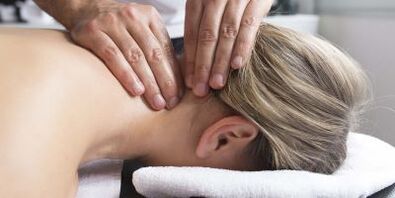
Now there are practically no people over the age of 25 who do not have spine problems. One of the most common pathologies is damage to the vertebrae of the neck, which, if left untreated, inevitably progresses and causes the patient increasing discomfort.
What is osteochondrosis
Osteochondrosis of the cervical spine is a degenerative-dystrophic change in the joints and intervertebral discs.
With the progression of cervical osteochondrosis, the following symptoms begin to appear:
decreased visual and hearing acuity;
numbness of the tongue;
with a sharp turn of the neck, dark in the eyes, it spins;
a pulsating pain is felt in the nape of the neck that can radiate to the temples and crown;
pain in the cervical spine and shoulders, which disturbs the patient even during sleep, and is aggravated by movement or strain;
stiff neck, especially in the morning;
sternum pressure;
shortness of breath, shortness of breath.
Due to the fact that the spinal cord does not receive enough nutrients, the range of motion, as well as the sensitivity of the upper and lower extremities, is significantly reduced.
Causes of cervical osteochondrosis
Predisposition to cervical osteochondrosis is hereditary. In addition, the common causes of pathology are:
unbalanced diet;
scoliosis;
flat feet;
VSD;
stress;
spinal injuries and bruises;
excessive physical activity;
rheumatism;
sedentary lifestyle;
overweight.
References! The main reason for the development of osteochondrosis is a violation of mineral metabolism, which may be associated with calcium deficiency or hormonal disorders. Women often face this pathology during pregnancy and menopause.
Diagnosis
The following diagnostic methods are used to determine the degree of degenerative changes in the spine:
Doppler ultrasound of the carotid and vertebral arteries. It allows you to detect varicose veins, as well as disrupt the blood supply to the brain and spinal cord.
Audiography to examine the work of the hearing organs.
Ultrasound.
CT and MRI of the head and cervical spine. It is performed with the aim of assessing the area of the lesion, checking the position of the intervertebral discs, detecting compression of the spinal cord and blood vessels.
Blood test.
X-ray in the early phase of pathology.
Electroneuromyography showing the presence of inflammation, pinching, and nerve damage.
Duplex scanning of blood vessels of the head.
References! All these procedures are most conveniently performed in one place, for example, in the treatment and rehabilitation center, where the diagnostics is performed with the help of modern equipment.
Which doctor treats
If symptoms of cervical osteochondrosis appear, you cannot start treatment immediately. First of all, you need to make an appointment with a neurologist. The specialist will perform an examination, and then refer the patient to the necessary studies.
Bitan! Carrying out manual therapy and other types of treatment without prior diagnosis threatens injuries and exacerbation of existing problems.
Methods of treatment
Once the diagnosis is made, the patient can begin treatment. Leading specialists work in treatment and rehabilitation centers, so the likelihood of complications is minimal.
The main method of treating neck osteochondrosis is manual therapy. The specialist makes a massage that relaxes the neck and shoulders, returns the vertebrae and joints to their natural position and works to normalize lymph flow and blood circulation.
Manual therapy is often combined with therapeutic exercises to tone the neck muscles. In addition, medications and physiotherapy are used to remove the pathology.
results
As a result of the therapy, the nerve endings are relieved of pinching, the spinal column is stabilized, and the pain disappears or decreases. A chiropractor can straighten the vertebrae and increase the distance between damaged discs, thus removing friction.
Bitan! Grade 2 and 3 osteochondrosis cannot be completely cured. But therapy and rehabilitation will allow the patient to restore damaged spine function as much as possible.
Rehabilitation and lifestyle recovery
In the treatment and rehabilitation centers, not only the diagnosis and treatment of cervical osteochondrosis is carried out, but also rehabilitation measures. The patient leaves the center healthy and ready to return to his usual way of life as soon as possible.
Rehabilitation is not only aimed at restoring the functioning of the spine, but also at preventing damage to healthy tissues. The program is compiled taking into account the severity of the pathology and the presence of complications. Physiotherapy procedures, massage, exercise therapy, mud applications have been well proven. If the patient still has symptoms of pathology, he is prescribed a drug blockade.
Lifestyle with cervical osteochondrosis
To avoid recurrence of the disease, you must adhere to the following recommendations:
change body position at least every half hour;
do not lift loads heavier than 5 kg;
walk more, do physical therapy, swim, pilates;
it is desirable to use not a bag, but a backpack;
when you are sitting, you take ten-minute breaks every hour.
Bitan! The position of the human body during sleep is of great importance. You need to sleep on your back, on a medium-strength orthopedic mattress and orthopedic pillow. In this case, the head and neck should lie on a pillow and the shoulders on a mattress.
Treatment of cervical osteochondrosis is most effective at an early stage, so you should not delay a visit to a neurologist. But it is possible to stop the progression of the disease and improve the quality of life regardless of the degree of damage to the joints and intervertebral discs. For this it is important not to waste time and follow the recommendations of experts.

















































